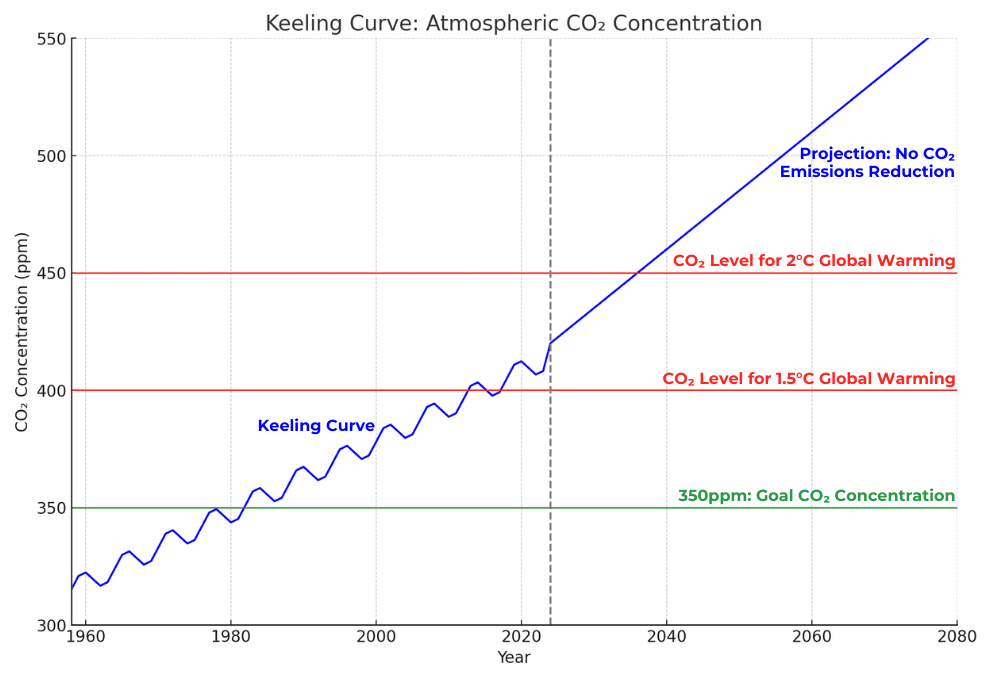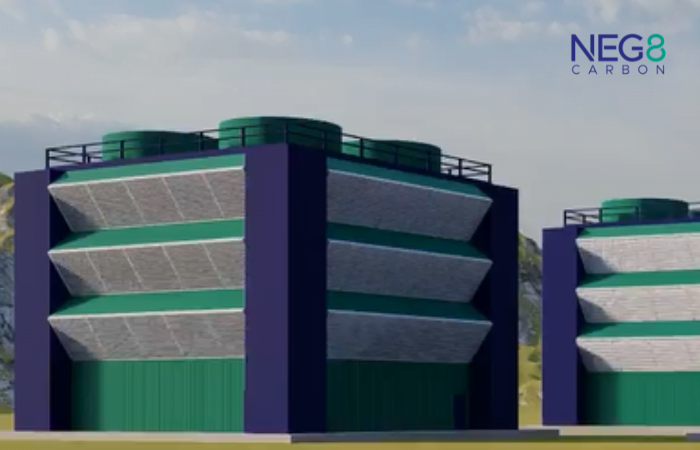Why Direct Air Capture?
By: Ray Naughton, Founder & MD of NEG8 Carbon
Direct Air Capture (DAC) technology is a targeted approach to addressing historical emissions, those vast quantities of CO2 that are already in the atmosphere and that are contributing to climate instability. As a technology, DAC holds immense promise in the fight against climate change.
Reducing Carbon Emissions
Is Not Enough
In Parts Per Million (ppm)
Measured at Mauna Loa Observatory in Hawaii
December 2025: 427.24 ppm
December 2024: 425.26 ppm
Safe level concentration: 350 ppm
Pre-industrialisation level: 280 ppm
November 2025 average at NEG8 Carbon, Ireland: 398.12 ppm
Have a look here at Deep Sky’s collection of current climate change statistics.
Tackling the build up of carbon dioxide in the atmosphere is a two-prong approach:
1 – Reduce CO2 emissions
2 – Remove the legacy CO2 from the air
Although reducing carbon emissions and switching to renewable energy is an absolute necessity, it will not be enough. We need to remove the carbon dioxide that has already built up in the atmosphere since the beginning of industrialisation, and this is why Direct Air Capture stands out as an effective carbon removal option.
The Urgency of Carbon Reduction
The undeniable reality is that human activities, especially industrial processes, have drastically increased the concentration of greenhouse gases in the atmosphere. Carbon dioxide, a major contributor to the greenhouse effect, traps heat and raises global temperatures, leading to adverse impacts such as rising sea levels, extreme weather events, and disruptions to ecosystems.
At the moment, the carbon dioxide concentration in the air is around 428 parts per million (ppm). For the Earth to be at a safe level, this figure needs to get back down to at least 350ppm of CO2, a level last seen in 1988. This concentration is increasing by roughly 3 to 4 ppm each year. If this trend continues, the next 30 years could bring an additional 1°C rise in global temperature since industrialisation on top of the 1.5°C already observed.
Even if we manage to achieve net-zero emissions, the legacy CO2 will still need removing to bring us to the 350ppm level. Since the historic CO2 emissions will still remain in the atmosphere, it will take millenia for the Earth to cool down to safe levels if we don’t remove the CO2 using carbon capture technologies.
The last 10 years have been the hottest on record with 2024 being the hottest of all. Furthermore, for every additional 1 ppm of CO2 in the air, the surface temperature rises by 0.01°C.

The Climate Clock
Our current weather predicting technology is not able to keep up with the rapid escalation of climate disasters in recent years. However, we do have one consistent source of data that provides us with an indication of the level of urgency we face regarding climate change.
Since 1958, the Mauna Loa Observatory in Hawaii, as part of the Scripps CO2 Program, has been recording the level of CO2 in the atmosphere and has been plotting it on the Keeling Curve.
 |
This graph clearly demonstrates how human activity has affected the rise of CO2 in our atmosphere and how we are fast approaching critical levels. It’s a real-time counter that shows us where we stand and serves as a wake-up call to anyone who might doubt the severity of our situation. This clock isn’t just about alarmism; it’s a tool for understanding our position in this crisis.
For a daily snapshot of the CO2 concentration in the atmosphere and the Earth’s surface temperature, see: CO2 Daily
DAC’s Role in Carbon Dioxide Removal
Understanding Direct Air Capture
At its core, Direct Air Capture is a technological process designed to remove carbon dioxide directly from the atmosphere. Unlike traditional carbon capture technologies that target emissions at their source (see Direct Air Capture vs Point Source), DAC offers a versatile and scalable solution by capturing CO2 from ambient air. But why is this so important?
A recent Intergovernmental Panel on Climate Change (IPCC) report highlights the role that DAC will have in limiting global warming to 1.5°C above pre-industrial surface temperatures. The IPCC AR6 Report (2023) indicates that achieving the 1.5°C Paris Agreement target will require carbon capture and storage (CCS) over and above emissions reduction efforts, with DAC playing a role alongside other CCS methods.
The AR6 WGIII Technical Summary notes: “Carbon Dioxide Removal (CDR) is necessary to achieve net zero CO2 and GHG emissions both globally and nationally, counterbalancing ‘hard-to-abate’ residual emissions.” Furthermore, it mentions that in pathways limiting warming to 1.5 °C global cumulative carbon dioxide removal from DACS over 2020–2100 is estimated at 0–310 GtCO2.
For more, see Why Removing CO2 from the Atmosphere is Urgent
Location Flexibility and Scalability of DAC
One of the key advantages of Direct Air Capture is its ability to function independently of emission sources. This means that businesses operating in diverse sectors can use DAC to offset their carbon footprint, irrespective of the nature of their operations. Whether manufacturing, technology, or any other industry, DAC provides a customisable solution to align with sustainability goals.
Moreover, the scalability of DAC sets it apart. As the demand for carbon offsetting grows, DAC can be expanded to capture larger volumes of carbon dioxide, ensuring that businesses can scale their environmental initiatives in tandem with their growth.
Meet Regulatory Requirement on Carbon Emissions: A Win-Win for Business and the Planet
Companies investing in DAC technology aren’t just reducing their environmental impact; they’re also gaining access to a valuable tool in the form of carbon credits. Carbon credits represent a quantifiable and tradable measure of the carbon dioxide removed from the atmosphere through DAC.
For multinational corporations, these carbon credits not only demonstrate a commitment to environmental responsibility but also present a unique opportunity for positive brand positioning. At a time when consumers increasingly prioritise sustainability, businesses that actively participate in carbon offsetting initiatives can differentiate themselves as leaders in the movement towards a greener future.
See: EU Climate Regulations Explained
Final Thoughts: Moving from Talk to Action
When the effects of climate change arrive at our doorsteps, it becomes much harder to ignore. Floods, fires, and extreme weather are no longer future scenarios—they’re happening now.
People will demand solutions, and stopping emissions is only part of the answer. Direct Air Capture provides a way to address historical emissions and reduce the CO2 that’s already causing damage.
It’s time for us to put these discussions into practice. With more investment, more innovation, and more action, DAC can become a major player in the fight against climate change. It’s not just about preventing more harm; it’s about actively repairing the damage already done.
For more:
- Direct Air Capture Cost Compared to Cost of Inaction on Climate Change
- Hard to Abate Industries and the Decarbonization Challenge
- Is DAC Viable?

